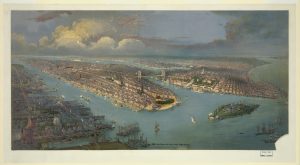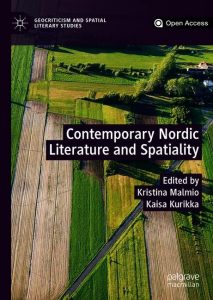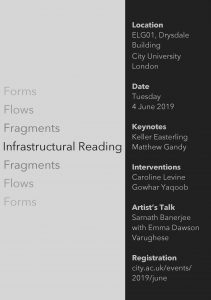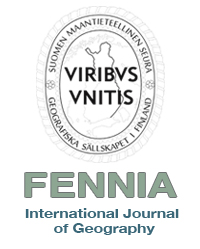Out now: The Materiality of Literary Narratives in Urban History (Routledge), edited together with Jason Finch, Silja Laine and Richard Dennis.
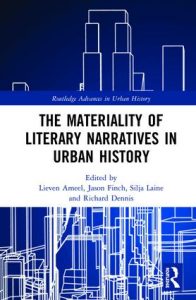
https://www.routledge.com/The-Materiality-of-Literary-Narratives-in-Urban-History/Ameel-Finch-Laine-Dennis/p/book/9780367343293
The publication is connected to my earlier work and work within the Association for Literary Urban Studies to examine the complex role of literary sources in urban history.
The introduction, “Urban History and the Materialities of/in Literature” gives an in-depth exploration of literature and materiality in the context of historical research of the (literary) city.
With contributions by Bo Pettersson, Markku Salmela, Aleksejs Taube, Silja Laine, Jason Finch, Lucie Glasheen, Flore Janssen, Richard Dennis, Julie Gimbal, Huda Tayob, Elke Rogersdotter, and Anubhav Pradhan.
Several chapters draw on forms of literary and material evidence that are still often missing in examinations of the historical materialities of literary cities. Lucie Glasheen, in her chapter ”The Casey Court House Builders’: 1930s Children’s Comics and the Material Transformation of East London”, for example, examines comic reels in a popular children’s magazine to explore attitudes toward urban transformation in the inter-war period; Huda Tayob, in “The Unconfessed Architectures of Cape Town”, draws on archival material, architectural research, and photographs to question the role that literary texts can play in responding to the archival silences of subaltern architectural and urban histories.
Thanks to all the contributors and to co-editors Jason Finch, Silja Laine and Richard Dennis for work on this exciting volume!
Summary of the book:
“The Materiality of Literary Narratives in Urban History explores a variety of geographical and cultural contexts to examine what literary texts, grasped as material objects and reflections on urban materialities, have to offer for urban history. The contributing writers’ approach to literary narratives and materialities in urban history is summarised within the conceptualisation ‘materiality in/of literature’: the way in which literary narratives at once refer to the material world and actively partake in the material construction of the world. This book takes a geographically multipolar and multidisciplinary approach to discuss cities in the UK, the US, India, South Africa, Finland, and France whilst examining a wide range of textual genres from the novel to cartoons, advertising copy, architecture and urban planning, and archaeological writing. In the process, attention is drawn to narrative complexities embedded within literary fiction and to the dialogue between narratives and historical change.
The Materiality of Literary Narratives in Urban History has three areas of focus: literary fiction as form of urban materiality, literary narratives as social investigations of the material city, and the narrating of silenced material lives as witnessed in various narrative sources.”
From the Preface:
“This collection of essays has its origins in a long-term interest the editors have in city literature and its meanings for our understanding of the urban experience. It is based on a session held at the European Association for Urban History (EAUH) conference in Helsinki in 2016. The session,
‘Urban History and the Materiality of Literary Narratives in Urban History’, proved to be remarkably successful – we had planned for one session with four papers but received thirty proposals, from which we were able to choose twelve that formed a coherent whole. These complemented each other and were sophisticated in their approach to literary texts while remaining analytical in questions regarding materiality and history. The response to the call for papers, as well as the lively discussions during and after the EAUH conference, highlighted an ongoing need to improve understanding of how fictional and literary sources can be used and interpreted in the field of urban history. The present book was planned around a core group of the papers read at EAUH 2016, complemented with chapters by invited authors, among them three of the editors.
The ideas, concepts, and methodological approaches presented in this volume were further developed in seminars organised by the Association for Literary Urban Studies (ALUS); at a particularly stimulating one-day symposium, ‘The City: Myth and Materiality’, at the Institute of Historical Research (IHR), University of London; and in cooperation with the Turku Institute for Advanced Studies and ALUS. The starting point of the symposium was similar to that in this book: to explore how cities have always been driven by the dynamic interaction of myths and materialities, and to examine such oscillations between fictional representations and the material conditions of city sites. The keynote talk presented by Richard Dennis provided the basis for his chapter in this volume.”
Table of Contents
1. Urban History and the Materialities of/in Literature
Lieven Ameel, Jason Finch, Silja Laine and Richard Dennis
Part I: Literary Fiction as Urban Materiality
2. Between the Street and the Drawing Room: Slumming in Eliot’s Early Poetry
Bo Pettersson
3. Recycling Fictions in the City: Don DeLillo and the Materiality of Waste
Markku Salmela
4. Embodied Experience of London’s Material Structures in Peter Ackroyd’s Hawksmoor
Aleksejs Taube
5. Sensory Environments of Poverty Seen Through the Writings of Runar Schildt, Toivo Tarvas, and Elvi Sinervo
Silja Laine
6. “Quite an Aristocratic Place, Although in Whitechapel”: Hospital Topographies and Margaret Harkness’s Writing of London
Jason Finch
Part II: Literary Narratives as Social Investigations of the Material City
7. “The Casey Court House Builders”: 1930s Children’s Comics and the Material Transformation of East London
Lucie Glasheen
8. “On the Square”: Constructing the Dangers of Depression-Era London in Ada Chesterton’s Social Investigations
Flore Janssen
9. “Would You Adam-and-Eve-It?”: Geography, Materiality and Authenticity in Novels of Victorian and Edwardian London
Richard Dennis
10. The Literary Adventure of the Skyscraper in France (1893–1930): Literary Narratives and Urban Architecture Between Fiction and Reality
Julie Gimbal
Part III: Narrating Silenced Material Lives
11. The Unconfessed Architecture of Cape Town
Huda Tayob
12. Contestant City Tales: Searching for a “Literary City” Through Archaeology
Elke Rogersdotter
13. Memorialising Materiality: Narrative as Archive in Neo-Liberal Delhi
Anubhav Pradhan
